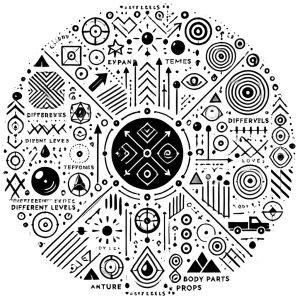InnerMotion – The Guidebook – Experiment

Experimenting with your dance is a great way to discover new moves, improve your technique, and keep your dancing fresh and exciting. Being playful and open to trying new things can lead to innovative and unique expressions in dance. Here are several examples of how you can experiment with your moves:
- Switch Up the Tempo: Dance to the same song at different speeds. Try slowing down fast songs and speeding up slow ones to see how it changes your movements.
- Quieting and Amplifying: Play with the intensity of your movements. Start with subtle, almost imperceptible motions, then gradually amplify them to full expression.
- Expanding and Contracting: Expanding your body (or a feeling of your energy body) to take up more space and then contracting to become small and compact.
- Receiving and Giving: Dance as if you are receiving energy from those around you and then giving it back through your movements. This can create a dynamic exchange between you and your fellow dancers.
- Change Levels: Shift between dancing low to the ground and then making big moves upward. Playing with levels adds a dynamic visual element to your dance.
- Reverse Your Moves: If you have a signature move, try performing it in reverse. This can lead to interesting variations and new dance patterns.
- Restrict Movements: Limit your dance to just one part of your body. For example, dance using only your arms or only your legs. This can help you explore the range of expressions possible within constraints.
- Body Part Guidance: Let different parts of your body guide your movements. Begin with an unexpected starting point - your elbow, knee, or even your head - follow where it leads you and allow the motion to flow naturally from there.
- Imitate Nature: Imagine you're a leaf blowing in the wind, a wave crashing in the ocean, or a flame flickering in the fire. Emulating elements of nature can transform your movement quality and bring a new narrative to your dance.
- Imitate Animals: Channel the movements of different animals. How would a cat slink through space, or an eagle soar? Let these animalistic traits inspire your dance.
- Mirror Dancing: Pair up with a partner and mirror each other’s movements. This can be a fun way to come up with new ideas.
- Incorporate Props: Use a hat, a scarf, or even a chair in your dance. Each prop can inspire different movements and add a theatrical element to your routine.
- Random Music Selection: Shuffle your music library and dance to whatever plays next, regardless of the genre. This can challenge you to adapt your movements to match the music.
- Silent Dancing: Dance without music and focus on the rhythms your body wants to create. This can help you explore your natural movement impulses.
These approaches allow you to explore and expand your dance capabilities in creative and innovative ways. By embracing experimentation, you not only develop a richer movement vocabulary but also deepen your connection to your body and the music. Each new challenge invites spontaneity, adaptability, and a sense of play, making your dance more dynamic and fulfilling. Whether you're refining a personal style, breaking habitual patterns, or simply having fun, approaching dance with curiosity and openness can lead to unexpected discoveries and deeper self-expression. Keep exploring, trust your instincts, and let your creativity flow.